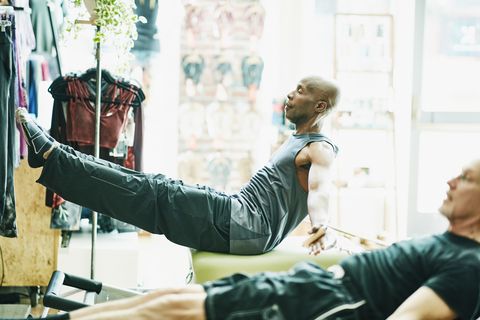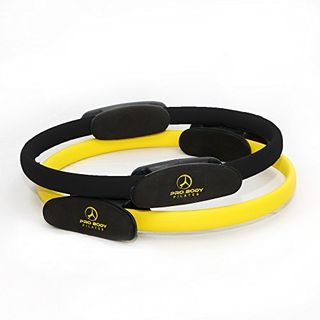Men Should Start Adding Pilates to Your Home Workouts. Here's How.
Before you grab your weights, you might want to consider another way to get your health and fitness on track. Maybe you’re feeling strong—but are you feeling stiff? Too much sitting at your work-from-home station? Pilates might be just what you need to balance your body and optimize your strength.
Don’t just scoff. Despite what you might envision when you think of Pilates, this form of exercise is great for men. In fact, it was started by a man named Joseph Pilates, and he was no sissy (he started developing the method while being held in an internment camp, for starters). You can read more about Joseph Pilates and the fascinating history behind this workout practice here—but if you are still not convinced that Pilates might be what your body needs, take it from an expert.
Dr. Heather Mims, PT, DPT, OCS, PMA-CPT and Pilates Method Alliance Certified Pilates Teacher at Shift Wellness, says that the balance the practice can bring is essential for men. “Many men need to include a better balance of work on flexibility and strength in their exercise programs,” she says. Dr. Mims explains that traditional workouts targeted towards men disproportionately concentrate on resisted strengthening programs that forcibly contract and shorten muscles. But this constant process of contracting muscles can lead to chronic tightness and decreased range of motion.
If you don’t diversify your workout routine, Dr. Mims warns, a reduction in mobility at the joints can play a role in the development of common conditions such as low back pain, tendinopathies, muscle strains/tears, and plantar fasciitis. One of the many benefits of Pilates is that it includes a better balance of stretching and strengthening and often works the muscles in an elongated position, offering a long lever arm for the core muscles to work against.
Dr. Mims explains that eccentrically loading the muscles (resistance while lengthening rather than shortening them) in a slow, controlled “putting on the brakes” manner can offer really valuable functional strength training and stability work that can help men (and everyone else, for that matter) attain and maintain better posture and more efficient technique in their chosen sport, all while preventing injuries.
Not sure where to begin? Dr. Mims breaks down five of her favorite Pilates moves you can do at home, specifically for your man-bod.
5 Pilates Moves for Men
Thomas BarwickGetty Images
1. Hamstring Stretch with Pilates Magic Circle:
Lie on your back and hook one handle of the Pilates Magic Circle (or Ring) on the ball of your right foot. Straighten your right knee as much as you can, feeling a stretch in the back of your right thigh, knee, and calf. For 6 slow counts, push your right leg away from you but hang onto the Circle so that any actual motion is prevented (this is an isometric contraction of your right hamstrings). Relex, taking up the slack until feeling a stretch behind the leg. Hold 30 seconds. Repeat this cycle two more times.
Pilates Ring
ProBody Pilates
amazon.com
$39.96
$26.95 (33% off)
SHOP NOW
Dr. Mims explains: “This way of opening up the hamstrings makes use of an evidence-based stretching method known as Contract-Relax technique, which is part of PNF (Proprioceptive Neuromuscular Facilitation) techniques often utilized by physical therapists. By pairing the technique with the Pilates Magic Circle, you can stretch by yourself and achieve the same dramatic improvements in flexibility that we often see only when working with a trainer or PT.
2. Double Leg Lower/Lift:
Lie on your back and extend both legs straight toward the ceiling. If you cannot achieve completely straight knees, that’s okay—but extend as much as possible. Tuck your chin and float your head and shoulders off the floor, looking toward your abdominals. You can support the back of your head with one or both hands if you wish. As you slowly exhale, lower both straight legs until feeling a little shaking in your abdominal muscles. Do not go any lower if you begin to feel pain or strain in the lower back. This should be an abdominal experience, not a back experience. Inhale, raising both straight legs up to vertical again. Perform 6 to 8 reps total.
Besides being a great way to work on core strength, this is a particularly good exercise to do right after stretching the hamstrings, as it strengthens into the available range of motion and thus helps make new gains in hamstring flexibility into longer-lasting changes in the muscles and connective tissue.
3. Bridge with Single Leg Lower/Lift
Lie on your back and bend both knees with feet hip-width apart on the mat. Exhale, raising the pelvis up into a bridge. Extend the right leg straight toward the ceiling, maintaining the height of the pelvic bridge. Inhale, lowering the straight right leg toward the mat and stopping when it is just slightly lower than the L knee. Exhale, raise the straight right leg again to vertical. Repeat for a total of 5 down/up motions of the right leg, then replace the right foot to bridge position and lower pelvis down to the mat. Repeat 5 times on the left side.
This bridge variation has the winning combination of strengthening and stretching the hamstrings in a dynamic and balanced way throughout the activity while also offering core strengthening and dynamic hip flexor stretching.
4. Leg Pull Front Support
Set up a plank position. Make sure that you can feel your abdominals supporting the weight of the pelvis in the plank and that you are actively standing tall on your arms (not sinking between your shoulder blades). Inhale to prepare. Exhale as you kick twice toward the ceiling with a straight right leg, taking care to make the kicks small enough that the knee does not bend, the rest of the body does not reverberate or shift in any way, and the pelvis does not creep upward out of its plank alignment. Replace right foot, then perform 2 kicks on the next exhale with the left leg. Continue alternating sides for a total of 5 to 6 kicks on each side. This exercise offers core and upper body strengthening in an elongated position of the body, as well as a balance challenge due to the perturbations created with the kicking motions.
5. Side Kick on Forearm
Set up a side plank with feet stacked one on top of the other and top arm extended toward the ceiling. Lift top leg off bottom leg so that it is slightly higher than the top hip. Exhale and kick the top leg forward twice without disturbing the position of the rest of the body (no collapse on supporting arm, no swaying or wavering of top arm, no twisting of shoulders/chest/pelvis). Then, on your inhale, sweep the top leg back behind you staying above hip height. Repeat for a total of 5 to 6 on the first side, then flip over to the other side and perform 5 to 6 on the second side.
This exercise offers coordinated shoulder girdle, core, and pelvic girdle strengthening, dynamic hamstring stretching, and is particularly good for strengthening obliques and gluteus medius muscles (hip abductors).
Source: Read Full Article


